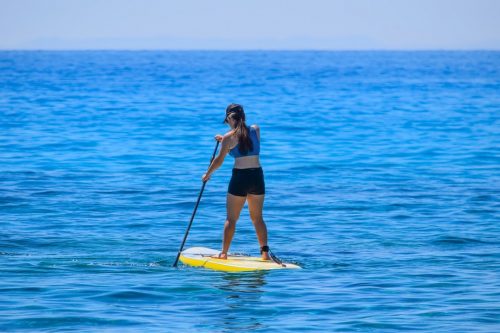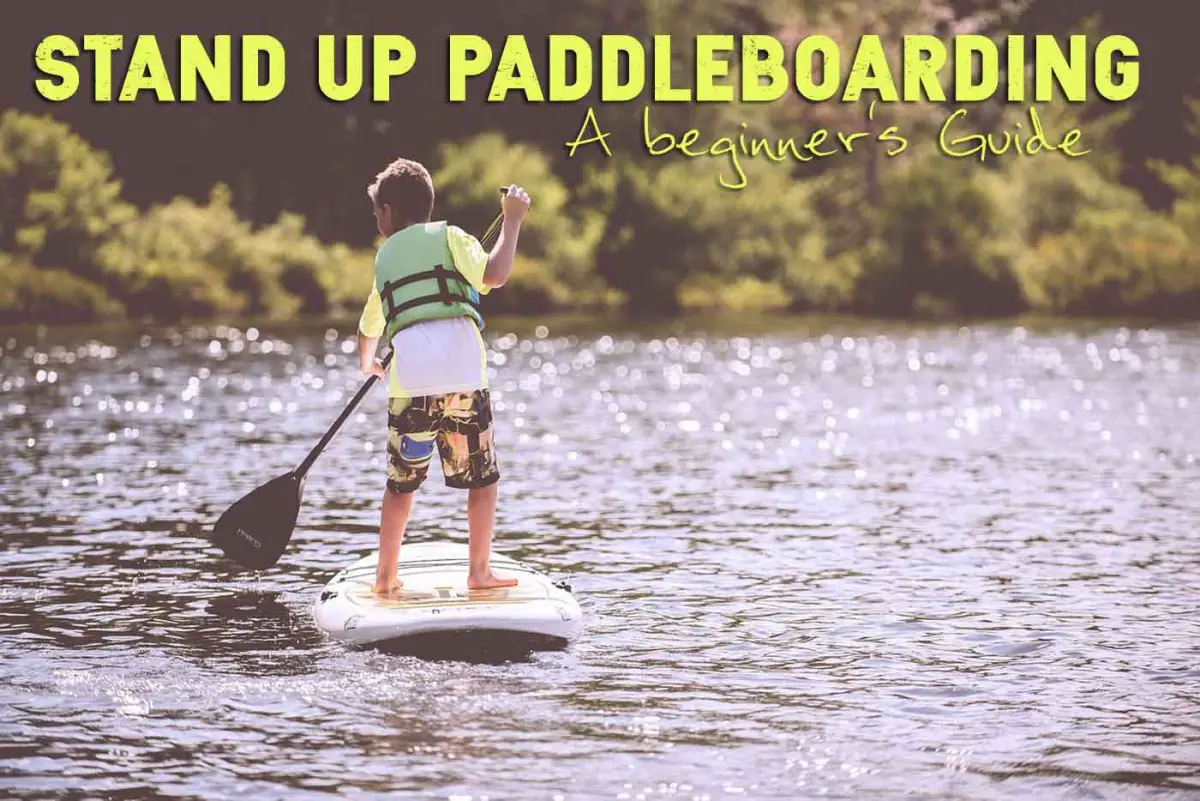Standup paddleboarding is a fun, relatively simple activity that involves a long wide board that you stand on as it floats on the water’s surface. It is the world’s fastest-growing watersport and there is no question as to why.
You make use of one paddle to turn you and propel you across the water. It is common to stand up paddleboard in calm waters such as lakes, but many people are even taking them out on the ocean and facing small waves.
Stand up paddleboarding is a great family activity, and has even been combined with activities such as yoga. This article is designed to help you learn the basics of stand up paddleboarding so that you can go and enjoy it at any time.
Choosing Your Board
There are many types of standup paddles boards available to use so it very important that you select the best type for you.
Hull Types
The hull type is the general shape of the board. There are two to choose from.
Planing Hull
This is a wide flat shape that is designed for a stable ride. It has a shape that is similar to a surfboard. For beginners, it is recommended to choose a board with a planing hull.
Displacement Hull
Boards with a displacement hull are typically longer and narrower. At the front is a pointed end similar to a canoe. The point is designed to cut through the water and push it around which creates a fast efficient ride.
These boards are great for touring and races but are not recommend for beginners as they are less stable (more tippy).
Board Weight Capacity
Every stand up paddleboard has a weight capacity. This simply states how much weight each board will correctly carry. If you are too heavy for the board it will sit low in the water making it difficult to paddle.
The higher the board’s volume, the more it will be able to carry.
Length
As a beginner, it is best to choose a medium length board. These typically range from about 9-12 feet long. These boards are great for use on calm waters as well as in the surf of oceans.
For kids and people who plan on only boarding in the surf, get a board that is under 9 feet long.
Boards that are over 12 feet in length are best for touring and racing. However, these are only recommended if you have some prior standup paddleboarding experience.
Width
For beginners, it is best to start on a wide board (31” or wider). The large surface area will create a stable platform to stand on.
Narrow boards (29”-30”) are typically much faster and are more likely to tip.
Fins
For the purpose of this article, stay away from race fins. A large single fin or 3-fin setup typically works best for beginners.
Board Make-Up
Stand-up paddles boards’ can be made using a variety of materials. Here is a quick breakdown of each.
Hollow Core
Plastic shells feature hollow centers inside the board. On high-end boards, this is often specifically done to save weight.
Polyurethane Foam
A relatively heavy foam center is used on lower-end boards. It is wrapped in fiberglass or plastic and epoxy.
EPS Foam
an EPS foam core is typically wrapped in fiberglass or other light plastics and epoxy. EPS is lighter than polyurethane.
Inflatable PVC
Inflatable boards tend to be quite durable and are easy to store. There are also relatively lightweight.
Other Equipment
Leash
Similar to how it is in surfing, a leash is important as it keeps the board attached to you. This prevents you from losing it in the water. Leashes attached around your ankle and have a cord that attaches to your board.
Leash choice is dependent of the type of paddle boarding you do. There are river, surf and flatwater leashes available so be sure to choose the right one.
Life Jacket (PFD)
It is recommended to use a life jacket at all times in order to prevent drowning. When used outside of the confinements of swimming specific areas, paddles boards are deemed as vessels.
This means that it is required for users to wear a PFD in these situations. Pick a jacket that has a snug fit and that you will not slip out of.
Paddle
For standup paddleboarding, choose a paddle that is 6-10 inches taller than you. The handle should be comfortable for you to hold. Also notice that some paddles have a bend in the shaft. This is designed for maximum paddling efficiency.
Board Bag
A simple yet important investment. A board bag is designed to keep your stand-up paddleboard from getting damaged. The also feature handles which makes carrying the board much easier.

Standing on the Board
For beginners, standing up on the board can be the task that makes them the most nervous. However, this should not be the case as it is quite simple.
Once the board is in the water, and is deep enough that the fin(s) will not hit the bottom, it is safe to mount the board.
Climb onto the board while remaining on your knees. You want to be just in front of the center. Hold the paddles parallel in front of you (horizontally across the width of the board).
The paddle can be then used to help keep your balance. When you feel stable, place one leg ahead of your other and start getting up onto it. Slowly follow with your other leg until you are up on both feet.
Now stand with your legs shoulder-width apart. This is the general paddle boarding position.
For turning you should stand in a similar shoulder-width position. The only difference is that you want to be a little closer to the back. This will make turning much more efficient.
Basic Paddling Techniques
Standup paddleboarding revolves strongly around the use of your core muscles. Using only your arms will leave you tired and with poor technique.
Remember that your core is a large muscle group, and it can handle strenuous activities much better than just your arms. Keep the core engaged whenever you are paddling.
Holding the Paddle
You want to hold the paddle with one hand on top of the handle and the other on the shaft. Do not put both hands on the shaft of the paddle, this is a common mistake that people make.
The top of the handle will feel comfortable to hold and direct as the other hand on the shaft will help keep the stroke steady when power is transferred.
Forward Stoke
Setting up for the stroke, you want your legs slightly bent, and your bottom arm straight with the paddle reached out far in front of you. Your top arm (the one on the handle of the paddle) should be at a 5 to 10-degree bend.
Keep your shoulders facing in the direction you intend to travel.
Move your shoulders and hips forward, and bend your knee that is on the side of the board where you are doing your stroke to place the blade in the water.
Drive your stroke side hip backwards while placing your weight onto the paddle though your top arm. You should now be moving forwards.
As you move past the paddle, move your stroke side hip forward and bring the paddle back to starting position.
Commit to 5 to 7 strokes on each side of the board before changing to the other side to stay straight.
Turning Stroke (Sweep Stroke)
The most common and simple way to turn on your paddleboard is by using sweep strokes. Sweep strokes work well when moving forwards or at a standstill.
To start, get into a neutral paddling position. Bend your knees slightly more than you would if you were making a normal forward stroke.
Reach far ahead of you and rotate your body as you would for a normal forwards stroke.
Plant the paddle in the water close to the nose and then pull it so that it makes a big arc away from your board. At this point you should be turning.
Sweep strokes can be made on either side of the board and also done in reverse. A reverse sweep stroke will stop any forward momentum so they are better to use at a standstill.
Final Thoughts
Standup paddleboarding is a fun sport that also provides a great core workout. By reading and understanding this article you are off to a great start. To learn more, videos are also great as they provide a visual representation of what you are supposed to do.
If you are up for it, there are also lessons available that will teach you the basics as well as ensure you have a well-fitting board. Now it is time you get out on the water and enjoy the experience!

